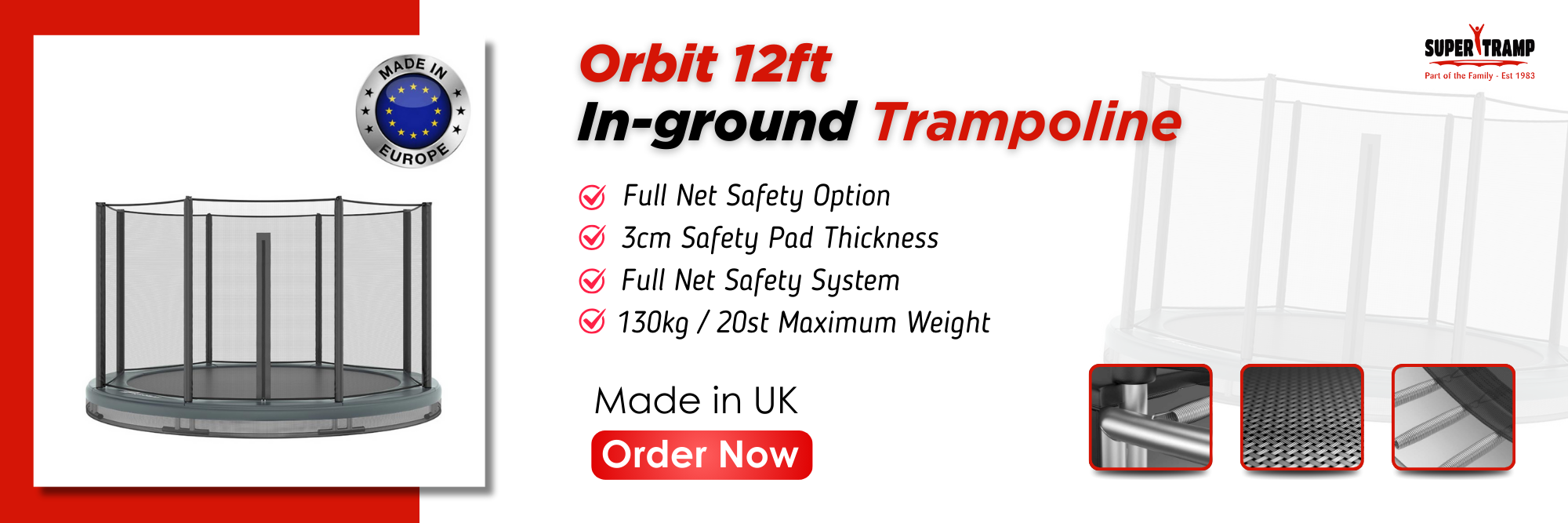Have you ever considered what makes trampoline frame pads your ultimate safety shield? Probably not—and that’s exactly why it’s so easy to make the wrong choice for your loved ones. Trampolines bring joy, laughter, and fun, but without the right frame pads, they can also invite unnecessary risks.
Table of Contents
ToggleTrampoline frame pads act as unsung heroes, creating a protective barrier between the jumper and the metal frame, preventing painful injuries that could ruin the fun. The right pads, crafted from the perfect material, can make all the difference between a quick wear-out and a lasting safeguard.
Just like choosing the best shoes for running, the right fit ensures comfort and protection, while a poor choice leads to blisters and discomfort. In the same way, knowing the materials used in trampoline frame pads can help you select the perfect one for your trampoline, ensuring years of safe and enjoyable bouncing.

So, if you want your trampoline to remain the safest spot for fun, take a moment to learn about what goes into those frame pads. With the right information, you can make the best choice for your family—one that lets you bounce without a care, knowing everyone is safe. Keep reading, and we’ll guide you through everything you need to know to make the best decision for your trampoline and your loved ones.
What Are Trampoline Frame Pads?
Many of you may already be familiar with in-ground trampoline frame pads, but for those who aren’t, let’s uncover why they’re a must-have for your trampoline. These pads are the essential cushion that keeps you and your loved ones safe while bouncing. They cover the springs and outer frame, acting as a protective barrier between the jumper and the hard metal parts. They are a soft shield, absorbing impact and preventing injuries that could occur if someone accidentally lands on the frame or springs.
More than just a safety feature, frame pads enhance the comfort of your trampoline, allowing everyone to jump without worry. Plus, they can even make your trampoline look more eye-catching by adding a pop of colour!
Now that you know what trampoline frame pads are, let’s dive into why they’re so important for reducing risk and how they keep the fun going.
How Trampoline Frame Pads Reduce the Risk

When it comes to trampolining, safety is always the top priority. The thrill of bouncing high into the air is unmatched, but an uncovered round trampoline frame can quickly turn that fun into a painful experience. Trampoline frame pads serve a vital purpose by protecting jumpers from the hard metal frame and springs. Without them, landing on these parts could lead to serious injuries, such as bruises, sprains, or even more severe accidents.
Let’s break down why these pads are a crucial part of trampoline safety:
- Safety is Priority: Having proper frame pads in place can lower the risk of injuries by up to 50%. This is why investing in high-quality frame pads is essential for anyone who owns a trampoline.
- Keeps Jumpers Safe from Injuries: Frame pads provide crucial cushioning between the jumper and the trampoline’s hard edges, offering protection against injuries and giving parents peace of mind.
- Made from High-Quality Material to Avoid Wear and Tear: Not all trampoline pads are created equal. The best ones are made from durable, high-quality materials like PVC or EPE foam. A pad that’s made from inferior materials may break down over time, leaving gaps in the protection.
High-quality frame pads from Super Tramp Trampoline are also UV-resistant and weatherproof, making them ideal for UK weather, where rain and sunshine can take a toll on outdoor equipment.
By choosing high-quality frame pads, you ensure that your trampoline remains safe for many years to come.
- Boosting Confidence and Encouraging Play: Trampoline frame pads boost confidence by providing a sense of safety, and encouraging more active play for a better trampoline experience.
Now that we’ve established the importance of trampoline frame pads and how they reduce the risk of injury, let’s tackle a common issue many trampoline owners face: choosing the right pads. With so many options available, it can be tricky to know which ones will provide the best protection and last the longest.
Common Problems Faced When Choosing Safety Pads
Choosing the perfect rectangle trampoline frame pads for your loved ones can be tricky, especially with so many options available. It’s easy to feel overwhelmed without the proper knowledge to make a confident decision. Let’s explore some common issues people face when selecting safety pads and how you can avoid them to ensure maximum safety and durability for your trampoline.

Which Material Pads Will Be the Best for You?
With so many materials available, it’s easy to get confused. Low-quality pads made from thin foam or subpar PVC may appear to save money initially, but they often wear out quickly. Doing your research on materials is crucial for both durability and safety.
Which One Will Fit Your Trampoline Best?
Finding the right size and fit for your trampoline can be challenging. If the pads are too loose, they may shift during use, leaving gaps that expose the springs or frame. On the other hand, pads that are too tight can create stress on the material, leading to quicker wear and tear. Proper measurements are essential before buying.
How to Maintain Frame Pads?
Even the highest quality pads will degrade without proper care. Regular cleaning and storing the trampoline indoors during extreme weather conditions can extend the lifespan of the pads.
Different Weather Concerns
In regions like the UK, where the weather can be unpredictable, concerns about how pads handle rain, frost, and UV rays are common. Safety pads not built for the outdoors can fade, crack, or lose their cushioning ability when exposed to these elements. Therefore, it’s important to look for pads made with weatherproof materials. UV resistance will keep them from degrading in the sun, while water-resistant coatings will protect against moisture.
Are They a Safe Option?
Some buyers find themselves questioning if the pads they choose are truly safe. Always check for thickness and the quality of the foam used in the padding to ensure it will absorb enough impact to prevent injuries. Remember, the thicker the pad, the safer the jumpers will be.
Which Brand Will Give Me the Best One?
The market is flooded with 12ft trampoline pads from various brands, but not all of them live up to their promises. It’s essential to choose a trusted brand that has positive reviews and a history of delivering high-quality products. Brands with a good reputation often offer warranties, which can give you peace of mind knowing you’re making a sound investment.
Now that we’ve looked at the common problems when choosing trampoline frame pads, let’s move on to the different types of materials used. Knowing the materials can help you choose the best option for both safety and durability. Stay tuned as we explore the types of pads that will make your trampoline safer and more comfortable for years to come.
Different Types of Materials Used to Make Safety Pads

When it comes to 14ft trampoline safety pads, the materials chosen can significantly impact their performance, comfort, and overall safety. Understanding the different options available allows you to make a well-informed decision. Let’s explore the most common materials used for trampoline frame pads, along with their pros and cons.
Polyethylene (PE)
Polyethylene (PE) is often the go-to choice for those on a tight budget. This lightweight material is easy to find but has limitations.
Pros
- Affordability: One of the most cost-effective options on the market.
- Lightweight: Easy to handle and install.
Cons
- Durability Issues: More likely to wear down quickly, especially in outdoor conditions.
- Limited Protection: Offers basic cushioning but doesn’t absorb shocks as effectively as other materials.
- Short Lifespan: Often requires replacement within 6 months due to degradation.
Polyvinyl Chloride (PVC)
Polyvinyl Chloride (PVC) stands out for its durability and resilience against outdoor elements, making it a popular choice for trampoline owners.
Pros
- Weather Resistant: Designed to withstand rain and UV rays, making it ideal for outdoor use.
- Strong and Durable: Often reinforced with fibres for added strength and longevity.
- Excellent Shock Absorption: Provides significant protection against impacts, enhancing safety.
Cons
- Higher Cost: More expensive than PE, but the investment pays off in durability.
- Heavier: Can be bulkier to handle compared to lighter materials.
Expanded Polyethylene (EPE) Foam
Expanded Polyethylene (EPE) foam is commonly found in budget trampoline pads. Its lightweight nature makes it easy to manage, though it has some drawbacks.
Pros
- Recyclable: Made from eco-friendly materials, contributing to sustainability.
- Soft and Comfortable: Provides a pleasant surface for jumpers, enhancing comfort.
Cons
- Lower Durability: Tends to compress over time, reducing its protective capabilities.
- Basic Protection: This may not offer enough safety for frequent or intense use.
- Shorter Lifespan: Often requires replacement sooner than more durable options.
Polyurethane (PU) Foam
Polyurethane (PU) foam is known for its exceptional durability and cushioning properties. This material is an excellent choice for those prioritising safety.
Pros
- Superior Cushioning: High-density structure provides excellent shock absorption and protection.
- Highly Durable: Resistant to wear and tear, ensuring a long lifespan even with regular use.
- Effective Impact Resistance: Offers better safety against hard impacts compared to other materials.
Cons
- Higher Price Point: Generally more expensive than PE and EPE, but worth the investment for safety-conscious trampoline owners.
- Heavier Weight: Can be bulkier, making installation slightly more challenging.
Comparison of Materials
- Cost: PE is the most budget-friendly, while PU foam tends to be the most expensive. PVC falls somewhere in the middle, offering a good balance between affordability and durability.
- Durability: PU foam and PVC are the most durable materials, designed to withstand heavy use and harsh weather conditions. EPE and PE are less durable, with PE being the least resistant to wear and tear.
- Safety: PU foam offers the best protection due to its high-density cushioning. PVC is also a strong contender, offering reliable shock absorption. EPE and PE provide basic protection but are less effective over time as they wear down more quickly.
For more informative guides like this don’t forget to visit m.supertramp.co.uk. And if your next question is how to install your high-quality material frame pads do explore our informative blog and install your frame pads hassle-free.
Super Tramp Trampoline wish you a Happy Bouncing
Final Thought
Choosing high-quality trampoline frame pads is crucial for ensuring the safety and enjoyment of your loved ones. By investing in the right materials, you not only enhance protection against injuries but also gain peace of mind while your family bounces away. Remember, a safe trampoline experience leads to countless joyful moments.
We invite you to explore the best options for trampoline frame pads and make an informed choice today. Share your trampoline stories with us—your insights could help others create a safer, more enjoyable jumping experience! After all, safety should always be a priority in fun.
FAQ's
The best material for trampoline mats is polypropylene or Permatron fabric, known for durability, UV resistance, and flexibility.
Trampoline padding is typically made of closed-cell polyethylene foam covered with a waterproof, UV-resistant PVC or vinyl exterior.
The best surface for a trampoline is a level, soft ground, such as grass or rubber flooring, to ensure stability and shock absorption.
Trampolines use galvanised steel for the frame, polypropylene for the mat, and PVC foam for the padding.
A trampoline mat typically lasts 3 to 8 years, depending on usage, weather exposure, and maintenance.





